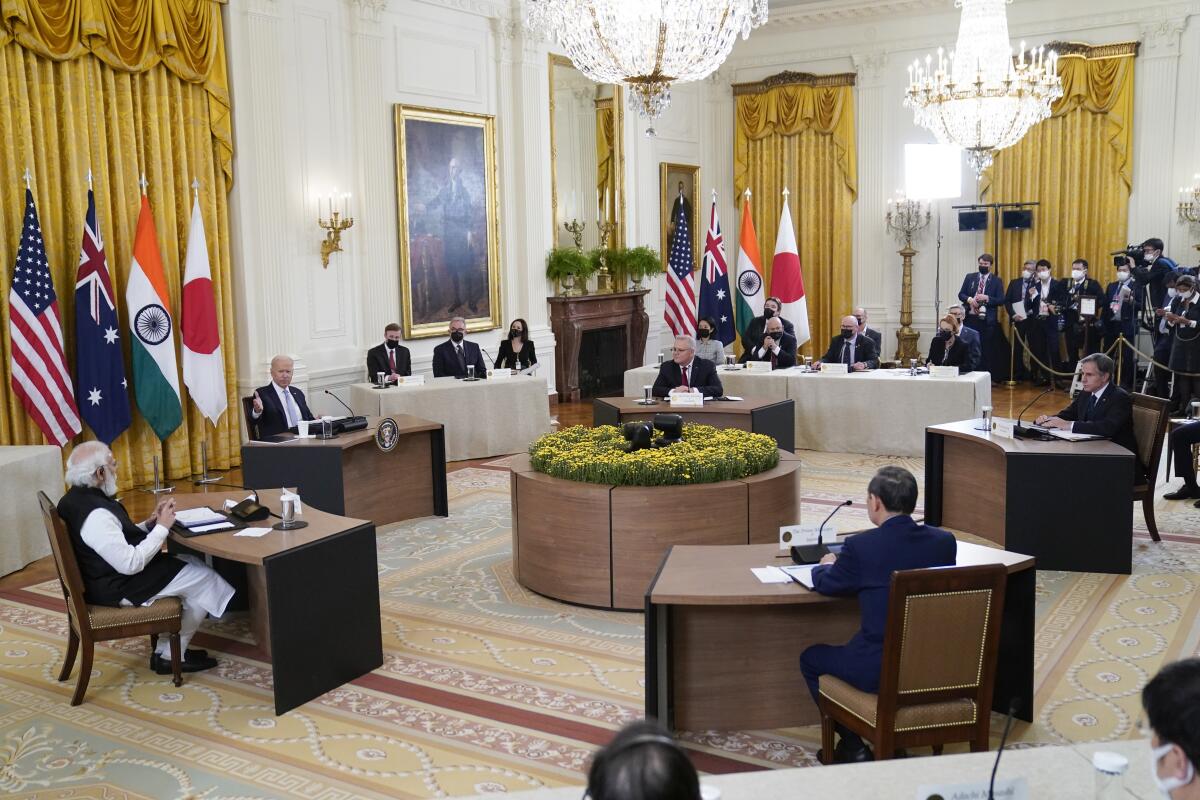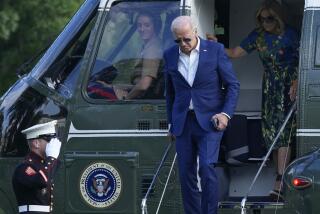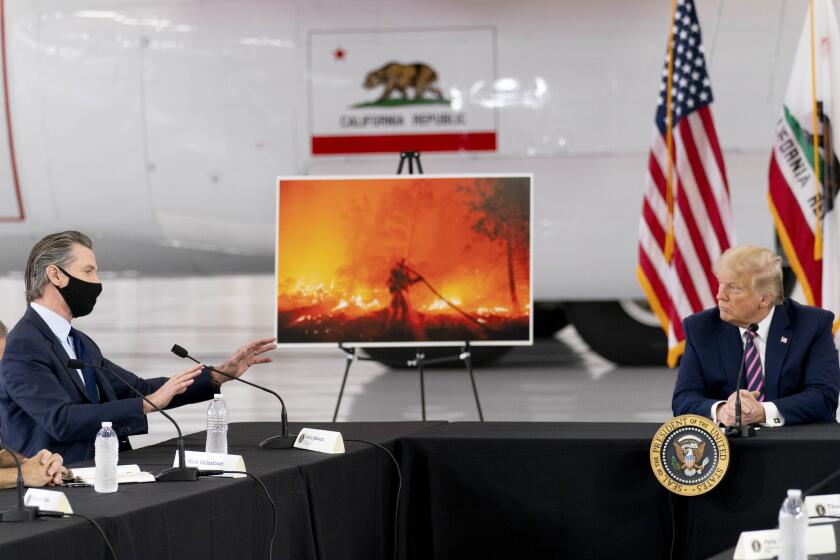Column: A new military alliance, a summit meeting: The U.S.-China face-off is looking like the Cold War

WASHINGTON — President Biden hosted a summit meeting Friday that could turn out to be a watershed — but if you weren’t watching, you might have missed it.
The meeting brought together the leaders of a deliberately low-key group called “the Quad”: the United States, Japan, India and Australia.
U.S. officials downplayed the session, describing it as “an informal gathering of leading democracies in the Indo-Pacific.”
The two are trying to distance themselves from the administration’s handling of the U.S.-Mexico border crisis, particularly the treatment of Haitian migrants.
China wasn’t fooled. Its diplomats have spent months denouncing the Quad as a Cold War-style alliance aimed at containing Beijing’s rise as the dominant power in Asia.
And they’re right.
Biden and his fellow Quad leaders never publicly uttered the word “China,” but the Quad is all about containment. It seeks to blunt China’s growing influence, deter it from launching military adventures and prevent it from muscling the United States and other countries out of Asia’s growing markets.
The Quad isn’t a military alliance — formally, at least. A Biden aide who briefed reporters before the summit took pains to make that point three times in 20 minutes.
But last month, four navies staged a massive military exercise in the Philippine Sea east of China. The participants were the same four: the United States, Japan, India and Australia.
All four are democracies. More to the point, all four have been alarmed to see China exert economic and military power to get its way — from seizing islands and building bases on contested territory in the South China Sea to threatening Taiwan and attacking Indian army positions in the Himalayas.
In Australia, the muscle China used was economic: After Australia called for an investigation of the origins of the coronavirus, Beijing retaliated by cutting imports of Australian beef and called on the Canberra government to stifle “anti-China statements” from members of Parliament and the media.
The naked pressure backfired; the Aussies got their backs up and decided to move closer to the United States.
One result was Aukus, the new military partnership of Australia, Britain and the United States, whose first big project is building nuclear-powered submarines for the Australian navy.
Between the Quad and Aukus, “we’re seeing the emergence of a new security architecture,” Bonnie Glaser, a China expert at the German Marshall Fund of the United States, told me. “It sends a signal to Beijing that other countries are willing to stand up together and defend a rules-based international order.”
Containing China has become a top priority of U.S. foreign policy, with coalition-building as Biden’s instrument of choice. That shouldn’t be surprising; it’s one theater in which the United States enjoys a clear advantage.
China is very good at many things: economic growth, large-scale construction projects, acquiring foreign technology, cyberespionage. But it hasn’t been successful at making friends. It’s a superpower with client states but no real allies, unless you count Pakistan and, recently, Russia.
That helps explain the fury of Chinese denunciations of the Quad, Aukus and other regional groupings: It’s a game they can’t play.
The question is whether China will launch a military challenge against the new coalition before the U.S. has time to consolidate it.
The test could come over Taiwan, the breakaway province that China’s ruling Communist Party has long vowed to reincorporate into the motherland.
“The standard view in Asia is that Taiwan is the canary in the coal mine,” said Elbridge Colby, a former Pentagon official whose new book, “The Strategy of Denial,” focuses on the U.S.-China confrontation.
The recently retired commander of U.S. forces in the Pacific, Navy Adm. Phil Davidson, warned in March that China could pose a serious threat to Taiwan “in the next six years,” Colby noted.
Chinese President Xi Jinping “can see that the trends are not favorable,” Colby said.
Australia’s new submarines could help deter a seaborne invasion, for example, but they won’t be in the water for more than a decade. So the Chinese leader could view the next few years as a last opportunity to take Taiwan by force.
“We should be worried,” Colby said.
If this is beginning to sound like the bad old days of the Cold War, when the United States and its allies obsessed over the prospect of a Soviet invasion of Europe, it should.
No historical analogy is perfect, of course. Our competition-plus-conflict with China is complicated by the two countries’ deep economic entanglement, which wasn’t the case with the Soviet Union.
But in most other respects, the comparison fits: two nuclear superpowers that disagree over ideology, often view global power as a zero-sum game and — in the case of the United States — build coalitions and alliances to reinforce their influence.
“We are not seeking a new Cold War,” Biden said at the United Nations last week. But thanks to Xi’s assertiveness, he’s gotten one — and no matter how soothing his words, he’s acting accordingly.
More to Read
Get the L.A. Times Politics newsletter
Deeply reported insights into legislation, politics and policy from Sacramento, Washington and beyond. In your inbox three times per week.
You may occasionally receive promotional content from the Los Angeles Times.












